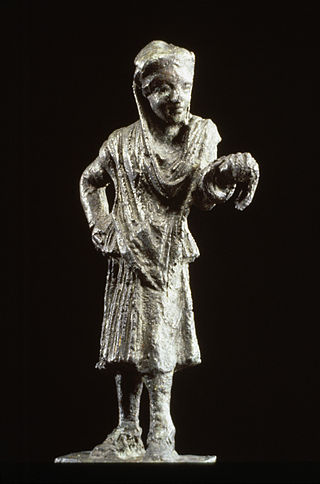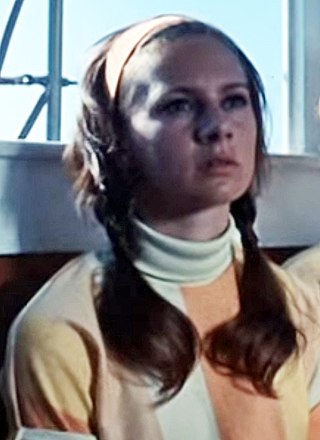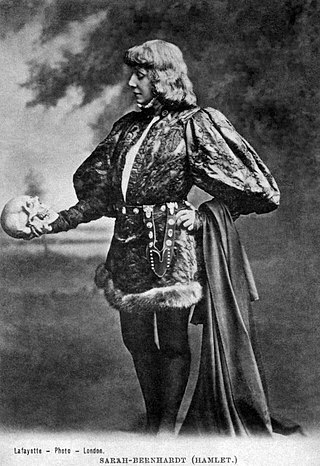Related Research Articles

The following outline is provided as an overview of and topical guide to theatre:

A theatrical culture flourished in ancient Greece from 700 BC. At its centre was the city-state of Athens, which became a significant cultural, political, and religious place during this period, and the theatre was institutionalised there as part of a festival called the Dionysia, which honoured the god Dionysus. Tragedy, comedy, and the satyr play were the three dramatic genres emerged there. Athens exported the festival to its numerous colonies. Modern Western theatre comes, in large measure, from the theatre of ancient Greece, from which it borrows technical terminology, classification into genres, and many of its themes, stock characters, and plot elements.

Francesca Annis is an English actress. She is known for television roles in Reckless (1998), Wives and Daughters (1999), Deceit (2000), and Cranford (2007). A six-time BAFTA TV Award nominee, she won the 1979 BAFTA TV Award for Best Actress for the ITV serial Lillie. Her film appearances include Krull (1983), Dune (1984), The Debt Collector (1999), and The Libertine (2004).

A mimeartist, or simply mime, is a person who uses mime, the acting out of a story through body motions without the use of speech, as a theatrical medium or as a performance art. In earlier times, in English, such a performer would typically be referred to as a mummer. Miming is distinguished from silent comedy, in which the artist is a character in a film or skit without sound.

Pantomime is a type of musical comedy stage production designed for family entertainment. It was developed in England and is performed throughout the United Kingdom, Ireland and in other English-speaking countries, especially during the Christmas and New Year season. Modern pantomime includes songs, gags, slapstick comedy and dancing. It generally combines gender-crossing actors and topical humour with a story more or less based on a well-known fairy tale, fable or folk tale. Pantomime is a participatory form of theatre, in which the audience is encouraged and expected to sing along with certain parts of the music and shout out phrases to the performers.

Ida Lvovna Rubinstein was a Russian dancer, actress, art patron and Belle Époque figure. She performed with Diaghilev's Ballets Russes from 1909 to 1911 and later formed her own company. Boléro by Ravel (1928) was among her commissions.

The architectural form of theatre in Rome has been linked to later, more well-known examples from the 1st century BC to the 3rd Century AD. The theatre of ancient Rome referred to a period of time in which theatrical practice and performance took place in Rome. The tradition has been linked back even further to the 4th century BC, following the state’s transition from monarchy to republic. Theatre during this era is generally separated into genres of tragedy and comedy, which are represented by a particular style of architecture and stage play, and conveyed to an audience purely as a form of entertainment and control. When it came to the audience, Romans favored entertainment and performance over tragedy and drama, displaying a more modern form of theatre that is still used in contemporary times.
Edith Hall, is a British scholar of classics, specialising in ancient Greek literature and cultural history, and professor in the Department of Classics and Ancient History at Durham University. She is a Fellow of the British Academy. From 2006 until 2011 she held a chair at Royal Holloway, University of London, where she founded and directed the Centre for the Reception of Greece and Rome until November 2011. She resigned over a dispute regarding funding for classics after leading a public campaign, which was successful, to prevent cuts to or the closure of the Royal Holloway Classics department. Until 2022, she was a professor at the Department of Classics at King's College London. She also co-founded and is Consultant Director of the Archive of Performances of Greek and Roman Drama at Oxford University, Chair of the Gilbert Murray Trust, and Judge on the Stephen Spender Prize for poetry translation. Her prizewinning doctoral thesis was awarded at Oxford. In 2012 she was awarded a Humboldt Research Prize to study ancient Greek theatre in the Black Sea, and in 2014 she was elected to the Academy of Europe. She lives in Cambridgeshire.

Drama is the specific mode of fiction represented in performance: a play, opera, mime, ballet, etc., performed in a theatre, or on radio or television. Considered as a genre of poetry in general, the dramatic mode has been contrasted with the epic and the lyrical modes ever since Aristotle's Poetics —the earliest work of dramatic theory.

Theatre or theater is a collaborative form of performing art that uses live performers, usually actors or actresses, to present experiences of a real or imagined event before a live audience in a specific place, often a stage. The performers may communicate this experience to the audience through combinations of gesture, speech, song, music, and dance. It is the oldest form of drama, though live theatre has now been joined by modern recorded forms. Elements of art, such as painted scenery and stagecraft such as lighting are used to enhance the physicality, presence and immediacy of the experience. Places, normally buildings, where performances regularly take place are also called "theatres", as derived from the Ancient Greek θέατρον, itself from θεάομαι.

An actor or actress is a person who portrays a character in a production. The actor performs "in the flesh" in the traditional medium of the theatre or in modern media such as film, radio, and television. The analogous Greek term is ὑποκριτής (hupokritḗs), literally "one who answers". The actor's interpretation of a role—the art of acting—pertains to the role played, whether based on a real person or fictional character. This can also be considered an "actor's role", which was called this due to scrolls being used in the theaters. Interpretation occurs even when the actor is "playing themselves", as in some forms of experimental performance art.

The history of theatre charts the development of theatre over the past 2,500-2,600 years. While performative elements are present in every society, it is customary to acknowledge a distinction between theatre as an art form and entertainment, and theatrical or performative elements in other activities. The history of theatre is primarily concerned with the origin and subsequent development of the theatre as an autonomous activity. Since classical Athens in the 5th century BC, vibrant traditions of theatre have flourished in cultures across the world.

Commedia dell'arte was an early form of professional theatre, originating from Italian theatre, that was popular throughout Europe between the 16th and 18th centuries. It was formerly called Italian comedy in English and is also known as commedia alla maschera, commedia improvviso, and commedia dell'arte all'improvviso. Characterized by masked "types", commedia was responsible for the rise of actresses such as Isabella Andreini and improvised performances based on sketches or scenarios. A commedia, such as The Tooth Puller, is both scripted and improvised. Characters' entrances and exits are scripted. A special characteristic of commedia is the lazzo, a joke or "something foolish or witty", usually well known to the performers and to some extent a scripted routine. Another characteristic of commedia is pantomime, which is mostly used by the character Arlecchino, now better known as Harlequin.
The Armenian Theater dates to before Roman times and is one of the oldest Eurasian theatrical traditions. Alongside Greek and Roman theatres, it stands as one of the world's most ancient theatres. The ancient and beloved form of theatrical art is lyrical (profound) drama, which exerted its influence on the folklore of the Near East, Balkan, and Apennine peoples. Within this cultural context, Armenian folk and mystical drama, characterized by its dance elements, also took shape. Although the ancient theatre system hasn't been preserved, it has left its linguistic marks.
Galeria Copiola was an ancient Roman dancer (emboliaria) and actress whom Pliny includes in a list of notable female nonagenarians and centenarians in his Natural History. Because of Pliny's notice, Galeria is one of the few performing artists in classical antiquity whose career milestones can be precisely dated.

Volumnia Cytheris was an ancient Roman actress and mimae dancer. She is foremost known as the mistress of several famous Romans.
Licinia Eucharis was an Ancient Roman stage actress. She was a star of the Theatre of ancient Rome, and belonged to the few known ancient actresses to achieve fame and respect in her profession during the Roman Republic.
Fabia Arete was a dancer, actress and singer in Ancient Rome.
Helladia (5th-century) was an Ancient Roman stage artist - an actress and dancer.

The theatre of Italy originates from the Middle Ages, with its background dating back to the times of the ancient Greek colonies of Magna Graecia, in Southern Italy, the theatre of the Italic peoples and the theatre of ancient Rome. It can therefore be assumed that there were two main lines of which the ancient Italian theatre developed in the Middle Ages. The first, consisting of the dramatization of Catholic liturgies and of which more documentation is retained, and the second, formed by pagan forms of spectacle such as the staging for city festivals, the court preparations of the jesters and the songs of the troubadours.
References
- 1 2 3 Stewart, Michael; Parnell, David; Whately, Conor (2022-03-30). The Routledge Handbook on Identity in Byzantium. Routledge. ISBN 978-0-429-63340-9.
- 1 2 3 4 Ferris, Iain (2021-01-15). The Dignity of Labour: Work and Identity in the Roman World. Amberley Publishing Limited. ISBN 978-1-4456-8422-2.
- ↑ Harvey, Brian K. (2016-02-11). Daily Life in Ancient Rome: A Sourcebook. Hackett Publishing. ISBN 978-1-58510-796-4.
- 1 2 Sewell, Jan; Smout, Clare (2020-04-29). The Palgrave Handbook of the History of Women on Stage. Springer Nature. ISBN 978-3-030-23828-5.
- ↑ Poli, Mattia De; Rallo, Giuseppe Eugenio; Zimmermann, Bernhard (2021-11-15). Sub palliolo sordido: Studi sulla commedia frammentaria greca e latina - Studies on Greek and Roman Fragmentary Comedies (in Italian). Vandenhoeck & Ruprecht. ISBN 978-3-949189-22-7.
- ↑ Pat Easterling, Edith Hall: Greek and Roman Actors: Aspects of an Ancient Profession